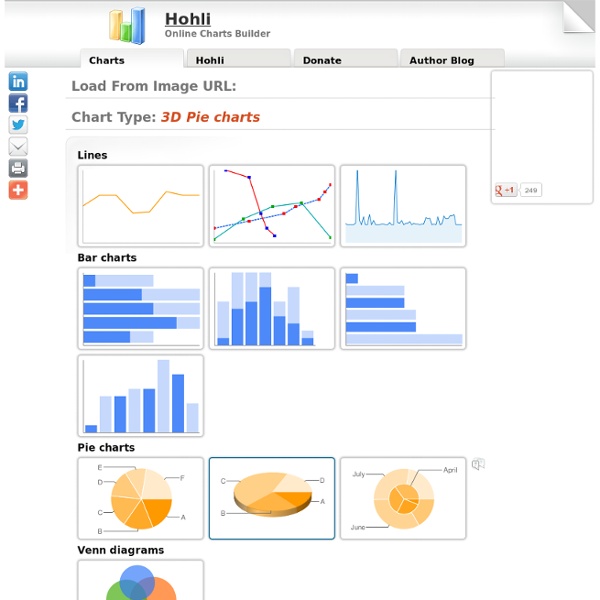Online Charts Builder

10 Awesome Free Tools To Make Infographics
Advertisement Who can resist a colourful, thoughtful venn diagram anyway? In terms of blogging success, infographics are far more likely to be shared than your average blog post. This means more eyeballs on your important information, more people rallying for your cause, more backlinks and more visits to your blog. In short, a quality infographic done well could be what your blog needs right now. Designing An Infographic Some great tips for designing infographics: Keep it simple! Ideas for infographic formats include: Timelines;Flow charts;Annotated maps;Graphs;Venn diagrams;Size comparisons;Showing familiar objects or similar size or value. Here are some great tutorials on infographic creation: Creating Your Infographic Plan and research.If required, use free software to create simple graphs and visualisations of data.Use vector graphic software to bring these visualisations into the one graphic. Free Online Tools For Creating Infographics Stat Planet Hohli Creately New York Times Many Eyes Wordle
KS1 Numeracy
A visual open ended activity to help with basic calculation and number bonds. Create number piles, Drag and drop the number bars to help explain a variety of concepts. A visual excersice to help with basic subtraction. Drag and drop the number bars to help with the calculation. © v2vtraining.co.uk A KS 1 money application where teachers and pupils can drag coins into a money box and then calculate the money box total. Open ended resource for teachers to ask their pupils questions as part of a whole class starter activity on money in maths. A KS 1 money application where teachers and pupils can choose items to buy and then pay for them by dragging coins onto a hand Uses coins 1p to 20p to a maximum total of £2.00 Drag and drop the toys onto the scales. The number cards can be used in a variety of ways in maths lessons. Try this progressive range of mental maths activities to sharpen recall of key number facts. © 3913.co.uk Drag and drop the names of the two digit numbers on to the picture.
Desktop
This software has been renamed to Gapminder World Offline Because of technical problems the software on this page is no longer being maintained! Please visit Gapminder World Offline (Beta) instead. Gapminder Desktop With Gapminder Desktop you can show animated statistics from your own laptop! Install With the Gapminder World you will be able to:Use the software without internet accessSave a list of your own favorite graphsUpdate automatically to the latest version Video: “How to use Gapminder Desktop” Installation instructions (Windows, Mac and Linux) 1. 2. If you are having trouble installing Gapminder Desktop using the button above you may try an alternative way.
ONLINE GRAPHS AND CHARTS | create and design your own graphs and charts online | INDEX
Infographic: Every Trip To The Moon, Ever
Once the U.S. planted a flag on the moon, it was easy to forget the trials and tribulations of the space race. But did you know that the United States and Soviet Union combined for eight failed missions to the moon within a single year? Eventually, the U.S. got the Pioneer 4 (their fifth attempt) to do a successful flyby in 1959. The Soviet Union followed a few months later by topping us big time--they actually landed with their Luna 2, a probe that looks straight out of 1960s sci-fi television. Click to enlarge. It’s a story that you can follow in this pair of infographics created by Margot Trudell as part of her OCAD graduate thesis. But if you like these infographics, you should check out Trudell’s entire graduate thesis, OMG Space. The pixel-scale chart of our solar system. And then she got really technical, in a graphic design explanation that may make you appreciate the size of our solar system just a little bit more: [Hat tip: Core77]
Related:
Related:



